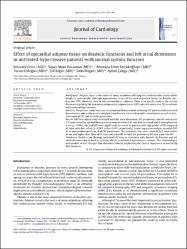Effect of epicardial adipose tissue on diastolic functions and left atrial dimension in untreated hypertensive patients with normal systolic function

Göster/
Erişim
info:eu-repo/semantics/openAccessTarih
2013Yazar
Çetin, MustafaKocaman, Sinan Altan
Durakoğlugil, Murtaza Emre
Erdoğan, Turan
Ergül, Elif
Doğan, Sıtkı
Canga, Aytun
Üst veri
Tüm öğe kaydını gösterKünye
Cetin, M., Kocaman, S.A., Durakoğlugil, M.E., Erdogan, T., Ergul, E., Dogan, S., Canga, A., (2013).Effect of epicardial adipose tissue on diastolic functions and left atrial dimension in untreated hypertensive patients with normal systolic function.Journal of Cardiology, 61(5-6), 359-364.https://doi.org/10.1016/j.jjcc.2012.12.015Özet
Background: Adipose tissue is the source of many adipokines affecting the cardiovascular system either locally or systemically. Although hypertension is one of the most important factors in diastolic dysfunction (DD), the exact cause of this relationship is unknown. There is no specific study in the current literature regarding the association of epicardial adipose tissue (EAT) with left ventricular DD in patients with essential hypertension. Methods: The present study was cross-sectional and observational, including 127 patients with untreated hypertension who underwent a complete transthoracic echocardiographic examination as well as measurements of EAT and diastolic parameters. Results: EAT was significantly correlated with left atrial dimension, DD parameters, and left ventricular (LV) mass as well as age and blood pressure measurements. EAT was also correlated with Framingham risk score (p< 0.001). Age and EAT were significantly increased in patients with high grades of DD compared to those with low values (p< 0.001 and p= 0.001, respectively). Linear regression analyses revealed EAT as an independent predictor of all DD parameters. The area under the curve values of EAT were similar to age and higher than those of LV mass and mean BP for both the presence of DD and grade two DD. Conclusion: Based on our findings, increased EAT may be associated with diastolic dysfunction and left atrial dilatation due to local or systemic effects in untreated hypertensive patients. This relationship is independent of and stronger than abdominal obesity, implicating the clinical importance of measuring EAT thickness. © 2013 Japanese College of Cardiology.

















